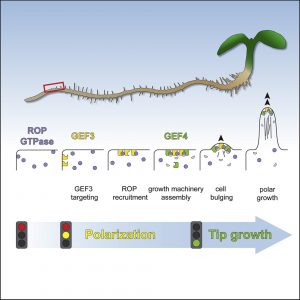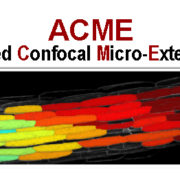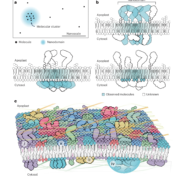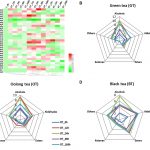Distinct RopGEFs successively drive polarization and outgrowth of root hairs (Curr. Biol) ($)
 Root hairs vastly increase the surface area of the root in contact with the soil substrate, and are crucial for efficient water and nutrient uptake. They are also an excellent system for studies of polar growth or tip growth in cells, a process that involves the cytoskeleton, defined membrane domains, and vesicle trafficking. Rho-type GTPases of plants (ROPs) are known to contribute to membrane fusion at the growing tip. RopGEFs are guanine nucleotide exchange factors that are needed for ROP activity. Denninger et al. showed that two RopGEFs are required for distinct stages of root hair outgrowth. GEF3 specifies the root-hair initiation domain, and GEF4 promotes outgrowth once this site has been specified. Interestingly, although plant and animal/fungal GEFs share function, they have no conserved features, indicating that “the problem of robust cell morphogenesis has been solved several times during evolution to account for specific differences in cellular growth mechanisms, organ development, and lifestyle.” (Summary by Mary Williams) Curr. Biol. 10.1016/j.cub.2019.04.059
Root hairs vastly increase the surface area of the root in contact with the soil substrate, and are crucial for efficient water and nutrient uptake. They are also an excellent system for studies of polar growth or tip growth in cells, a process that involves the cytoskeleton, defined membrane domains, and vesicle trafficking. Rho-type GTPases of plants (ROPs) are known to contribute to membrane fusion at the growing tip. RopGEFs are guanine nucleotide exchange factors that are needed for ROP activity. Denninger et al. showed that two RopGEFs are required for distinct stages of root hair outgrowth. GEF3 specifies the root-hair initiation domain, and GEF4 promotes outgrowth once this site has been specified. Interestingly, although plant and animal/fungal GEFs share function, they have no conserved features, indicating that “the problem of robust cell morphogenesis has been solved several times during evolution to account for specific differences in cellular growth mechanisms, organ development, and lifestyle.” (Summary by Mary Williams) Curr. Biol. 10.1016/j.cub.2019.04.059









